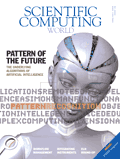 Nine years ago, I wrote in Scientific Computing World about using weightless neural networks from ITS to speed the sorting of decorated potsherds from an archaeological dig. It seemed pretty impressive at the time; nowadays, such is the march of progress, it seems laughable. Things move fast in information technology these days, even if implementation can’t always keep up with research and development. Within that statement of the obvious, computerised pattern recognition is an explosive growth area, with implications of which it is impossible to keep track. Within my adulthood, useful applications have graduated from science fiction fantasy to the stuff of day-to-day politics; and if events continue at the current rate, extrapolation suggests that I shall see Isaac Asimov’s I Robot[1] walking (or rolling) the earth before I die.
Nine years ago, I wrote in Scientific Computing World about using weightless neural networks from ITS to speed the sorting of decorated potsherds from an archaeological dig. It seemed pretty impressive at the time; nowadays, such is the march of progress, it seems laughable. Things move fast in information technology these days, even if implementation can’t always keep up with research and development. Within that statement of the obvious, computerised pattern recognition is an explosive growth area, with implications of which it is impossible to keep track. Within my adulthood, useful applications have graduated from science fiction fantasy to the stuff of day-to-day politics; and if events continue at the current rate, extrapolation suggests that I shall see Isaac Asimov’s I Robot[1] walking (or rolling) the earth before I die. Sounds fantastic? But all the key building blocks are already there, driven by political and commercial considerations. All of them are contentious: they collectively move George Orwell’s Big Brother from the pages of futurological fantasy into the weave of everyday life. On the other hand, they also represent new tools for science whose eventual use can hardly yet be guessed at, even by science fiction. While I deplore the first, I can’t put genies back into bottles and, that being so, their cooption to constructive ends becomes a matter of acute interest.
[machine vision, robotics]
1. Asimov, I., I, Robot. 1st ed. 1950, New York: Gnome Press.
No comments:
Post a Comment